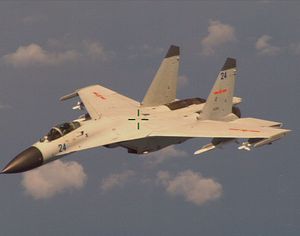A Boeing RC-135 reconnaissance aircraft operated by the U.S. Air Force (USAF) was intercepted by a People’s Liberation Army Air Force (PLAAF) Chengdu J-10 fighter jet in international airspace over the East China Sea on June 6, CNN reveals.
According to CNN, the incident has been confirmed by a number of officials in the U.S. Department of Defense, who characterize the intercept as “unsafe,” given that the Chinese jet flew within 100 feet (30 meters) of the RC-135 spy plane.
Details about the encounter over the East China Sea are sparse. One Pentagon official, however, revealed that the Chinese fighter jet flew at a “high rate of speed as it closed in.” The RC-135 aircraft was on a routine reconnaissance mission, according to U.S. defense officials.
“The officials did not know if the U.S. plane took any evasive action to avoid the Chinese aircraft or at what point the J-10 broke away. It is also not yet clear if the U.S. will diplomatically protest the incident,” CNN adds.
The last time China scrambled a fighter aircraft to intercept a U.S. spy plane near the East China Sea was in the last quarter of 2015. On September 15, two PLAAF warplanes intercepted a RC-135 reconnaissance aircraft about 80 miles (130 kilometers) east of the Shandong peninsular in the Yellow Sea. “The pilot reported that he felt … the aircraft passed in front of his nose in an unsafe fashion,” a Pentagon spokesperson said back then.
Last month, two Chinese fighter aircraft intercepted a U.S. EP-3 Aries signals reconnaissance aircraft in the South China Sea, an encounter the United States called a “dangerous intercept.” A similar incident took place in August 2014. As my colleague Ankit Panda explained in The Diplomat previously:
In 2001, a collision occurred between a U.S. EP-3 Aries and a Chinese fighter jet near Hainan Island. That incident resulted in the death of the Chinese pilot involved, damaged both aircraft, grounding the U.S. EP-3 on Hainan, and spiraled into a major diplomatic crisis.
To prevent a repeat of the Hainan incident, as the 2001 episode came to be known, the United States and China, in November 2014, adopted a memorandum to regulate the “safety of air and maritime encounters” between their militaries. In September 2015, the two countries added a supplement to strengthen the provisions of the joint memorandum.
It appears that the conduct of the Chinese fighter aircraft might have been in violation of procedures laid out in the joint memorandum, otherwise yesterday’s incident would not have been leaked to the press. (Chinese and U.S. military aircraft encounter each other on a regular basis in Asian skies.)
China’s recent action could perhaps be in retaliation to the U.S. Navy Chief of Naval Operations Admiral John Richardson’s recent visit aboard the Nimitz-class nuclear-powered supercarrier, USS John C. Stennis, in the South China Sea. The visit was purportedly meant to signal China that the United States will remain present in what Beijing claims are its waters.
In April, Japan reported an increase in Chinese military activity in the East China Sea. As I reported, the Japan Air-Self Defense Force (JASDF) had to dispatch its warplanes 571 times during fiscal year 2015 to intercept Chinese military aircraft approaching or intruding Japanese airspace, up from 464 sorties in 2014.
Meanwhile the eighth round of the annually-held China-U.S. Strategic and Economic Dialogue (S&ED) concluded in Beijing today.

































